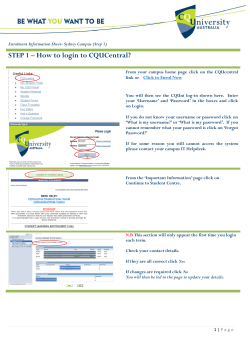
How to configure your Netgear DG834 Router for ADSL2+
How to configure your Netgear DG834 Router for ADSL2+ Connecting up your router This guide assumes that you have successfully: unpacked your router connected it up to your phone socket using the DSL cable and filter supplied in the box and connected a computer to the router using the supplied Ethernet cable. Configuring your router Once you have successfully connected up your router to both your phone socket and your computer, and powered both of these devices on, you are ready to configure your router. Open up your favourite web browser, e.g. Firefox or Internet Explorer, and in the address bar at the top, type in: http://192.168.0.1 – and then press Enter. You will be presented with a dialog box, similar to the one pictured below: For the username, type in admin – and for the password, type in password. Please note that both of these must be in lower case. You will then be presented with a configuration page, partially pictured below. You will need to select: No. I Want To Configure The Router Myself and then click on the Next button. You will now be on the Basic Settings page. Under Does Your Internet Connection Require a Login? You should select No. If your connection has a Dynamic IP, then under Internet IP Address, select Get Dynamically From ISP. If your connection has been assigned a Static IP, then under Internet IP Address, select Use Static IP Address, and then fill in the relevant boxes with the IP Address, IP Subnet Mask and Gateway IP Address supplied to you on your new connection’s Inventory Report. This should have been included inside the box of your new router. Once you have correctly entered your Internet IP Address details, as discussed above, you will need to scroll down the page to the Domain Name Server (DNS) Address settings. Select Use These DNS Servers, and for the Primary DNS server, enter 87.194.0.66 – and 87.194.0.67 for the Secondary DNS Server. The last step on this configuration page is to click Apply at the bottom of the page. Next, you need to specify the ADSL Settings. The ADSL Settings page is accessed by clicking on the ADSL Settings menu item, on the left hand side of your browser window. You will then need to set four options. For Multiplexing Method, click on the dropdown box and select LLC-Based. For VPI, type in 0 – and for VCI, type in 101. Lastly, for DSL Mode, click on the dropdown box and select ADSL2+. Once you have done this, don’t forget to click on Apply. You’re almost done now! You just have to configure the Wireless Settings, and then Set Password, and your router is all done. The Wireless Settings page is accessed by clicking on the Wireless Settings menu item, on the left hand side of your browser window (it is just underneath the ADSL Settings menu item that you clicked on in the last section). Once you are on the Wireless Settings page, you need to enter a simple, random name into the Name (SSID) box. This can really be anything you like, but you should change it from the default setting to prevent conflicting with other nearby wireless networks. Next, you need to set up the Security Options for your wireless network. From the long list, select WPA-PSK (Wi-Fi Protected Access Pre-Shared Key), and then in the box below, where it asks for Network Key, type in any password that you like, longer than 8 characters. You will need to remember this password to access your wireless network, so do pick a password you can remember. Don’t forget to click on Apply at the bottom of the screen once you have completed these steps. Onto the final step – setting a secure password for your router, so that no one can change configuration settings without authorisation. The Set Password page is accessed by clicking on the Set Password menu item, on the left hand side of your browser window, a few items below the menu items you were clicking on earlier. For Old Password, type in password – and then type in a secure password of your choosing for in both the New Password and the Repeat New Password boxes. Don’t forget to make a note of this new password. You have now completed your router setup!
© Copyright 2025



















![How to configure TL-WA5110G/TL-WA5210G as a repeater [FAQ ID: 348]](http://cdn1.abcdocz.com/store/data/000233066_1-8b0293b6e01296c3797b30e345a0cb36-250x500.png)

